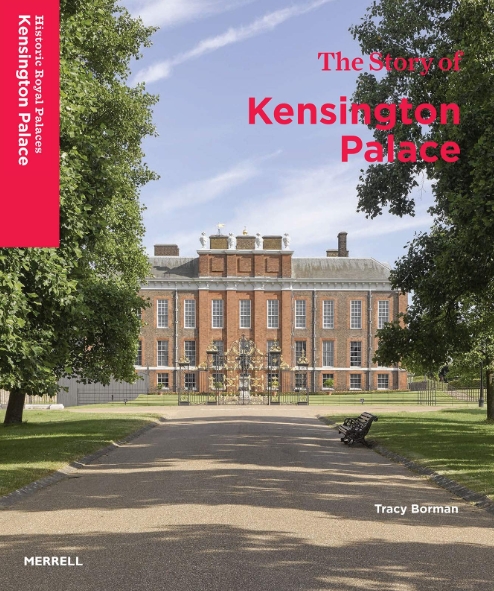The Story of Kensington Palace

|
| The Story of Kensington Palace, Tracy Borman, Merrell in association with Historic Royal Palaces, 2019, 160 pages, 200 colour and black and white illustrations, one plan, hardback. |
Kensington Palace is a complicated building composed of so many extensions dating from successive building campaigns that it is difficult to appreciate as a whole. Despite the contributions of significant architects and craftsmen such as Wren, Hawksmoor, Vanbrugh, Colen Campbell, Grinling Gibbons and William Kent, it lacks architectural cohesion and a single guiding hand to impose a unifying discipline over its many parts.
The building began life at the beginning of the 17th century as one of a group of small villas in the then rural village of Kensington to the west of London. It was built for the courtier Sir George Coppin, whose principal residence was in the Strand. Its distinctive double-pile plan with projecting bow windows is only known from the collection of architectural drawings made by John Thorpe, and one of the many virtues of this attractively produced book is the computer-generated reconstruction in full colour of its original form.
The villa was bought in 1689 by William III and Queen Mary as a retreat away from the unhealthy atmosphere at Whitehall Palace but with convenient access to the court in London. Its transformation into a Royal Palace was initially on a very modest scale but it was successively enlarged in a piecemeal fashion under the first two Hanoverian kings until the death of George II. It then became the home of younger members of the Royal family and further additions were made to accommodate them. It still fulfils that role today, but the State Apartments are open to the public under the meticulous care of Historic Royal Palaces and attract 600,000 visitors a year.
The complicated architecture and the garden setting provide the background for Tracey Borman’s book, but her main theme is the social and political significance of the palace, with a focus on the characters and the preferences of the individual personalities who shaped its development. The book is written in a chatty prose style liberally embellished with enticing anecdotes but soundly underpinned by historical scholarship. Its intended audience is undoubtedly the general public who visit in such large numbers, but there is much to enjoy for those with more specialised interests. The generous number of illustrations is a particular delight. They include historic prints and portraits, all reproduced with exceptional clarity, and an inspired collection of modern photographs of the palace today.
Of particular relevance is an account of the personal intervention of Queen Victoria, who had been born in the palace. In 1852 she resisted a proposal for its total demolition in order to build a new national gallery and in 1897 she promoted a restoration of the State Apartments, which had been unoccupied ever since the death of George II in 1760. It was her specific wish that they should be ‘opened to the public during her Majesty’s Pleasure’.
The works were completed in 1899 and, as a contemporary noted, ‘never before… has the restoration of any historic building been carried out with quite the same amount of loving care’. He went on to comment that careful attention had been paid ‘never to renew any decoration where it was possible to preserve it – least of all ever to attempt to “improve” old work into new’.
Such an approach can be rightly seen as a significant landmark in the conservation of historic buildings and their presentation to a wider public. The opening was an instant success and apart from brief interludes around both world wars, the palace and its gardens have remained accessible ever since. This beautifully produced guide book is a tribute to the thoughtful way in which they are presented to the public today.
This article originally appeared as ‘A palace and its people’ in IHBC's Context 159 (Page 62), published in May 2019. It was written by Malcolm Airs, Kellogg College, Oxford.
--Institute of Historic Building Conservation
Related articles on Designing Buildings Wiki
IHBC NewsBlog
Old Sarum fire in listed (& disputed) WW1 Hangar - Wiltshire Council has sought legal advice after fire engulfed a listed First World War hangar that was embroiled in a lengthy planning dispute.
UK Antarctic Heritage Trust launches ‘Virtual Visit’ website area
The Trust calls on people to 'Immerse yourself in our heritage – Making Antarctica Accessible'
Southend Council pledge to force Kursaal owners to maintain building
The Council has pledged to use ‘every tool in the toolbox’ if urgent repairs are not carried out.
HE’s Research Magazine publishes a major study of the heritage of England’s suburbs
The article traces the long evolution of an internal programme to research 200 years of suburban growth
IHBC Context 183 Wellbeing and Heritage published
The issue explores issues at the intersection of heritage and wellbeing.
SAVE celebrates 50 years of campaigning 1975-2025
SAVE Britain’s Heritage has announced events across the country to celebrate bringing new life to remarkable buildings.
IHBC Annual School 2025 - Shrewsbury 12-14 June
Themed Heritage in Context – Value: Plan: Change, join in-person or online.
200th Anniversary Celebration of the Modern Railway Planned
The Stockton & Darlington Railway opened on September 27, 1825.
Competence Framework Launched for Sustainability in the Built Environment
The Construction Industry Council (CIC) and the Edge have jointly published the framework.
Historic England Launches Wellbeing Strategy for Heritage
Whether through visiting, volunteering, learning or creative practice, engaging with heritage can strengthen confidence, resilience, hope and social connections.















